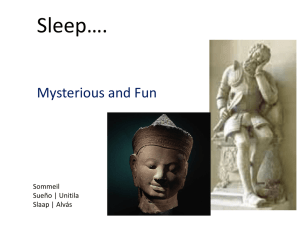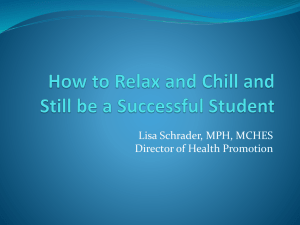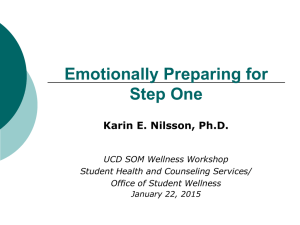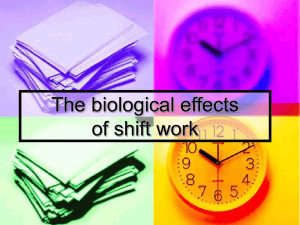Parasomnias in children
advertisement
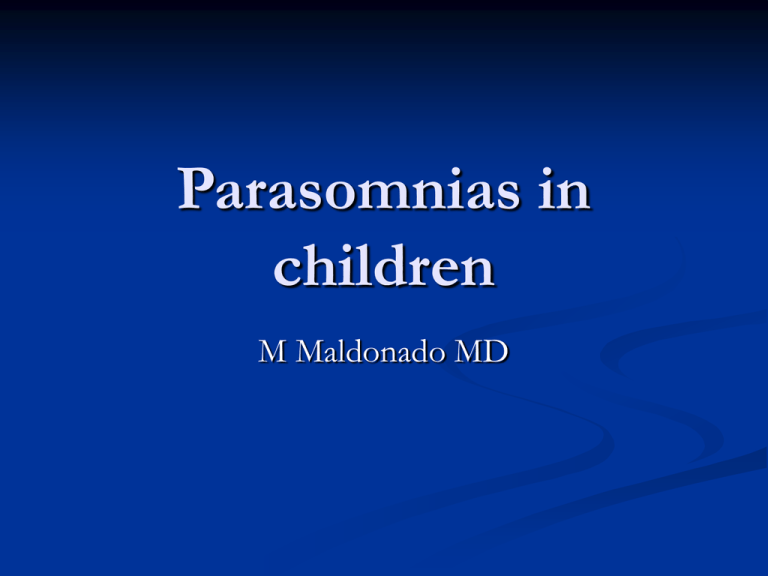
Parasomnias in children M Maldonado MD Classification During REM sleep During Non-REM sleep Mixed. Not to a particular state Secondary Parasomnias. Clinical Tend to occur in the transitions between the three states of the brain: Wakefulness- non-REM sleep-REM sleep Surprising no more parasomnias, given so many transitions Parasomnias/transitions Transition between REM Sleep and wakefulness : -Sleep paralysis -Lucid Dreams -Hypnagogic hallucinations Parasomnias, transitions Between NON-REM-Sleep and wakefulness: Confusional awakening Somnambulism Sleep terrors (Pavor nocturnus) Other parasomnias Within sleep itself ( Non REM to REM) Nightmares or Anxiety dreams -Behavioral disturbance during REM sleep -Hypnotic fright OTHERS. Bruxism, somniloquism, enuresis, restless leg Other disturbances during sleep CNS problems. Cephalgia (Headache), Seizures Cardiopulmonary problems: Arrhythmia during sleep. Hiccups during sleep. Angor pectoris. Respiratory dyskinesis Gastrointestinal Problems. Gastroesophageal reflux. Spasm of esophagus Mixed disturbances/parasomnias Panic attacks during sleep Dissociative states that occur during sleep Nocturnal leg cramps Malingering during sleep (eg. pretend one is sleep waking) Night eating syndrome Nightmares Anxiety dream, vivid recollection, perception as if reality Association with autonomous nervous changes Child regains consciousness fully after the nightmare Recollection the next day Fear of another nightmare May occur during later part of the night Awaking disorders Lack of response to environmental cues during the episode Automatisms, automatic behaviors during the episode Some degree of amnesia about the episode Confusional awakening Tends to occur during the first part of the night (first 1-3 hs) At the end of the first cycle of sleep When sleep goes from deeper to more superficial sleep Child may cry, gibber, attempt to move in uncoordinated way, not really awake Sleep terrors Initiated with a scream Child appears frightened May move as if to get away, get something off, or say things Not awake Not remember next day May last several minutes, up to 5-10 During the first part of the night Pavor nocturnus (sleep terror) Frequent cause of consultation and concern for parents Some children have more than one episode per night and they can be quite frequent Cause major disturbance to the possibility of rest and of the child waking up “refreshed” Sleep terror. Causes Genetic vulnerability and transmission Association with anxiety symptoms and preoccupations (Laberge et al, 2005) Possible association with traumatic experiences in some children? Awakening disorders, intervention Diminish sleep deprivation, deprivation predisposes to episodes Diminish the amount of stress Pre-emptive awakening during the first sleep cycle Medications? For severe cases Medications . Sleep terror Melatonin described as possibly useful L Trytophane Tricyclic antidepressants (e.g. amitriptyline or imipramine)

